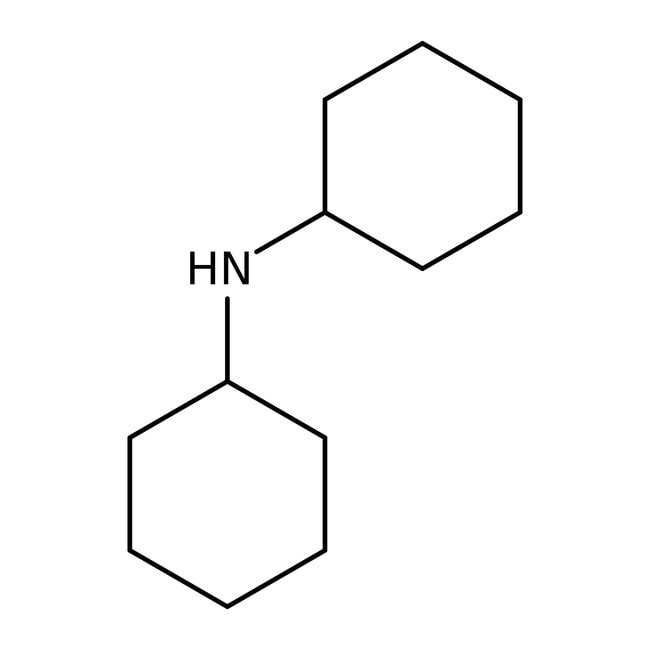Search Thermo Fisher Scientific
Thermo Scientific Chemicals
Dicyclohexylamine, 98%, Thermo Scientific Chemicals
Catalog number A15671.AE
also known as A15671-AE
Price (USD)/ Each
32.80
-
Quantity:
100 mL
Price (USD)/ Each
32.80
Dicyclohexylamine, 98%, Thermo Scientific Chemicals
Catalog numberA15671.AE
Price (USD)/ Each
32.80
-
Chemical Identifiers
CAS101-83-7
IUPAC NameN-cyclohexylcyclohexanamine
Molecular FormulaC12H23N
InChI KeyXBPCUCUWBYBCDP-UHFFFAOYSA-N
SMILESC1CCC(CC1)NC1CCCCC1
View more
Specifications Specification Sheet
Specification Sheet
FormLiquid
Identification (FTIR)Conforms
Refractive Index1.4825-1.4865 @ 20?C
Appearance (Color)Clear colorless to yellow
Assay (GC)≥97.5%
Dicyclohexylamine is used as an intermediate for the production of antioxidants and vulcanization accelerator. It is used as a catalyst for flexible polyurethane foams. It is also used in agrochemicals and textile chemicals. Used to constitute ionic liquid matrices for bacterial analysis in matrix assisted laser desorption/ionisation mass spectrometry.
This Thermo Scientific Chemicals brand product was originally part of the Alfa Aesar product portfolio. Some documentation and label information may refer to the legacy brand. The original Alfa Aesar product / item code or SKU reference has not changed as a part of the brand transition to Thermo Scientific Chemicals.
Applications
Dicyclohexylamine is used as an intermediate for the production of antioxidants and vulcanization accelerator. It is used as a catalyst for flexible polyurethane foams. It is also used in agrochemicals and textile chemicals. Used to constitute ionic liquid matrices for bacterial analysis in matrix assisted laser desorption/ionisation mass spectrometry.
Solubility
Sparingly soluble in water (0.8 g/L).
Notes
Air sensitive. Store under dry inert gas. Store in cool dry place in tightly closed container.
Dicyclohexylamine is used as an intermediate for the production of antioxidants and vulcanization accelerator. It is used as a catalyst for flexible polyurethane foams. It is also used in agrochemicals and textile chemicals. Used to constitute ionic liquid matrices for bacterial analysis in matrix assisted laser desorption/ionisation mass spectrometry.
Solubility
Sparingly soluble in water (0.8 g/L).
Notes
Air sensitive. Store under dry inert gas. Store in cool dry place in tightly closed container.
RUO – Research Use Only
General References:
- Hani Nasser Abdelhamid; Judy Gopal; Hui-Fen Wu. Synthesis and application of ionic liquid matrices (ILMs) for effective pathogenic bacteria analysis in matrix assisted laser desorption/ionization (MALDI-MS. Analytica Chimica Acta. 2013, 767 104-111.
- Bin Tao; and David W Boykin. Simple amine/Pd(OAc)(2)-catalyzed suzuki coupling reactions of aryl bromides under mild aerobic conditions. Journal of Organic Chemistry. 2004, 69 (13), 4330-4335.
- Forms highly crystalline salts with N-protected amino acids: Liebigs Ann. Chem., 640, 157 (1961).
- Reacts with n-BuLi to give a hindered strong base; cf LDA (see Diisopropyl amine, A10280), which has been used to promote, e.g. the ɑ -carboethoxylation of ketones; see Diethyl dicarbonate, B22753.

